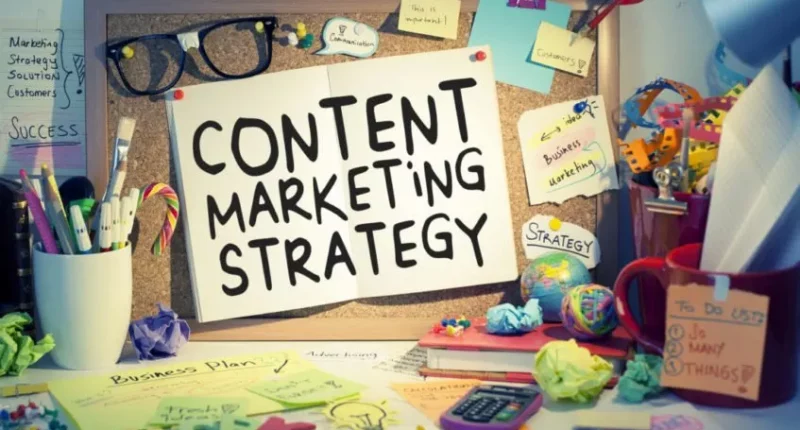Content marketing is one of the most powerful tools for building brand awareness, engaging your audience, and driving conversions. To maximize its potential, it’s essential to create a well-planned strategy that aligns with your goals.
How to Create an Effective Content Marketing Strategy
1. Define Your Content Marketing Goals
Before creating content, you need to establish clear goals for your content marketing efforts. Whether it’s building brand awareness, generating leads, or boosting sales, your goals will guide your strategy.
Key Content Marketing Goals
- Brand Awareness: Increasing visibility and reach.
- Lead Generation: Attracting potential customers to your website or offers.
- Customer Engagement: Building a relationship with your audience through valuable content.
- Sales: Driving conversions and revenue through targeted content.
2. Know Your Audience
Understanding your audience is critical for crafting content that resonates with them. Conduct research to identify your target audience’s demographics, interests, challenges, and preferences.
How to Identify Your Target Audience
- Create Buyer Personas: Develop profiles of your ideal customers based on demographics, behaviors, and needs.
- Analyze Customer Data: Use analytics tools and surveys to gain insights into your current audience.
- Understand Pain Points: Identify the challenges your audience faces that your content can help solve.
3. Perform a Content Audit
Before diving into new content creation, it’s important to review your existing content. A content audit helps you assess what content is performing well and what needs improvement.
Steps to Conduct a Content Audit
- Inventory Your Content: List all current blog posts, videos, and other content.
- Evaluate Performance: Use metrics like traffic, engagement, and conversions to assess each piece.
- Identify Gaps: Determine what topics or types of content are missing that your audience needs.
4. Research Keywords and Topics
Effective content marketing requires optimizing for search engines, so keyword research is a must. Identify the keywords and topics your audience is searching for to ensure your content gets found.
Tools for Keyword Research
- Google Keyword Planner: Discover popular search terms relevant to your industry.
- Ahrefs: Identify high-traffic keywords with low competition.
- SEMrush: Analyze competitors’ keyword strategies.
5. Create a Content Calendar
A content calendar helps you stay organized and consistent with your publishing efforts. Plan your content ahead of time to ensure a steady stream of valuable content for your audience.
How to Build a Content Calendar
- Set Publishing Frequency: Decide how often you’ll publish content (e.g., weekly, bi-weekly).
- Schedule Content Types: Mix up different formats like blog posts, videos, and infographics.
- Align with Key Dates: Plan content around industry events, holidays, or product launches.
6. Focus on Quality Over Quantity
It’s better to produce fewer pieces of high-quality content than to churn out a large volume of low-value posts. Focus on delivering informative, engaging, and well-researched content that answers your audience’s questions.
Elements of High-Quality Content
- Relevance: Address your audience’s interests and pain points.
- Depth: Provide detailed, well-researched information that adds real value.
- Clarity: Write in a clear, concise, and engaging manner.
- Visual Appeal: Include visuals like images, videos, and infographics to break up text.
7. Optimize Content for SEO
For your content to rank well on search engines, it’s essential to optimize it for SEO. This includes using the right keywords, writing compelling meta descriptions, and optimizing images.
SEO Best Practices for Content Marketing
- Include Keywords Naturally: Use target keywords in titles, headers, and body content without keyword stuffing.
- Write Engaging Meta Descriptions: Use a short, compelling description to encourage clicks from search engine users.
- Optimize Images: Compress images and use alt tags to describe them for SEO purposes.
8. Promote Your Content
Creating content is only half the battle. To reach a wider audience, you need to actively promote your content across multiple channels.
Content Promotion Strategies
- Social Media: Share your content on platforms like Facebook, Twitter, and LinkedIn.
- Email Marketing: Send your content to your email subscribers to drive traffic.
- Guest Blogging: Write guest posts on relevant websites to expand your reach.
9. Measure and Analyze Results
To understand the effectiveness of your content marketing strategy, track and analyze the performance of your content. Use analytics tools to measure key metrics such as traffic, engagement, and conversions.
Tools for Tracking Content Performance
- Google Analytics: Measure website traffic, user behavior, and conversions.
- Social Media Insights: Track likes, shares, and engagement across social platforms.
- SEMrush: Monitor keyword rankings and traffic growth.
10. Adjust and Improve Your Strategy
Content marketing is an ongoing process, and your strategy should evolve based on what works and what doesn’t. Regularly review your performance data and make adjustments to improve results.
How to Refine Your Content Strategy
- Test New Formats: Experiment with videos, podcasts, or interactive content to see what resonates with your audience.
- Update Old Content: Refresh outdated posts with new information and optimize them for SEO.
- Refine Audience Targeting: Use insights to better target specific segments of your audience.
Conclusion
Creating an effective content marketing strategy takes careful planning, research, and execution. By following these steps and continually refining your approach, you can develop a content marketing strategy that engages your audience, drives traffic, and boosts conversions.









